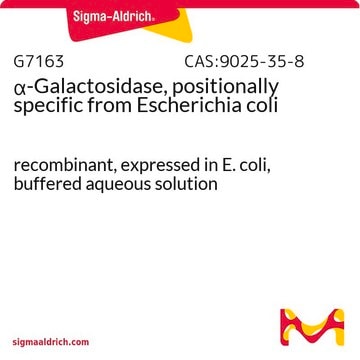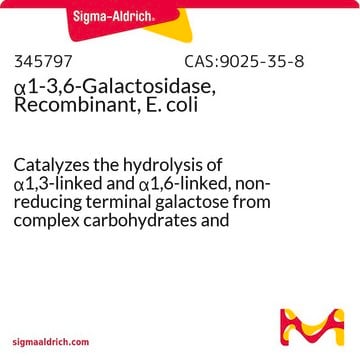G7673
α-Galactosidase I, Alkaline from Cucumis melo
Synonyme(s) :
α-D-Galactoside Galactohydrolase, Melibiase
About This Item
Produits recommandés
Produit recombinant
expressed in E. coli
Essai
≥85% (SDS-PAGE)
Forme
lyophilized solid
Activité spécifique
≥20 units/mg protein
Poids mol.
apparent mol wt ~84 kDa by SDS-PAGE
Conditions d'expédition
wet ice
Température de stockage
−20°C
Description générale
Application
Actions biochimiques/physiologiques
Propriétés physiques
Définition de l'unité
Forme physique
Mention d'avertissement
Warning
Mentions de danger
Conseils de prudence
Classification des risques
Eye Irrit. 2 - Skin Irrit. 2 - STOT SE 3
Organes cibles
Respiratory system
Code de la classe de stockage
11 - Combustible Solids
Classe de danger pour l'eau (WGK)
WGK 3
Point d'éclair (°F)
Not applicable
Point d'éclair (°C)
Not applicable
Faites votre choix parmi les versions les plus récentes :
Certificats d'analyse (COA)
Vous ne trouvez pas la bonne version ?
Si vous avez besoin d'une version particulière, vous pouvez rechercher un certificat spécifique par le numéro de lot.
Déjà en possession de ce produit ?
Retrouvez la documentation relative aux produits que vous avez récemment achetés dans la Bibliothèque de documents.
Filtres actifs
Notre équipe de scientifiques dispose d'une expérience dans tous les secteurs de la recherche, notamment en sciences de la vie, science des matériaux, synthèse chimique, chromatographie, analyse et dans de nombreux autres domaines..
Contacter notre Service technique








